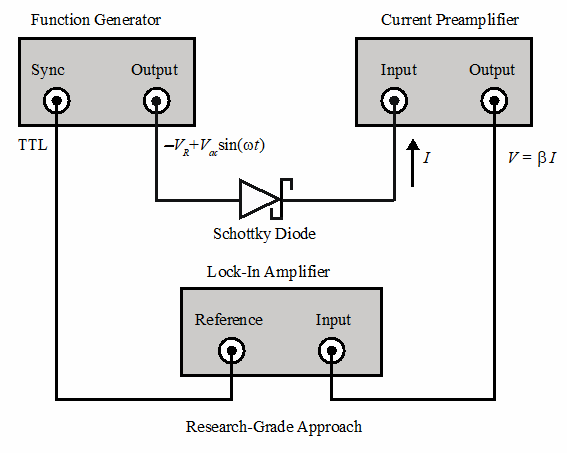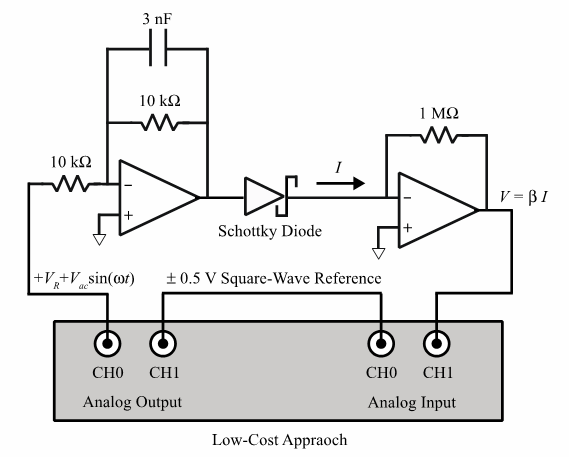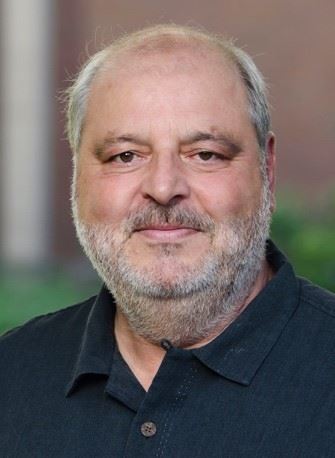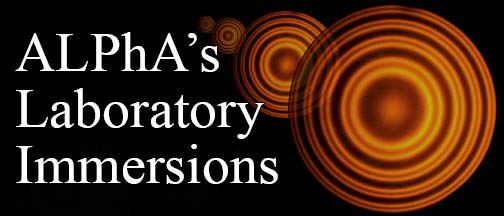- Home
- What We Do
- Laboratory Immersions
- Immersions 2022
- Imm2022Reed_DopantDensity
Reed College, Portland OR
Determining Dopant Density in Silicon via Capacitance Profiling
Dates: June 15, 2022 to June 17, 2022
Number of setups available: 2
Maximum number of participants: 4
------------------------------------------------------------------------------------------------------------------------------------------
Description
 In this semiconductor-physics-related Immersion, participants will implement capacitance-voltage profiling on a reverse-biased Schottky barrier diode to determine the density of impurity dopants in its semiconductor layer as well as its built-in electric potential. A commercially produced Schottky diode will be used as the sample. Data acquisition and analysis will be carried out under computer-control using LabVIEW software written by the participants (however, data may also be acquired manually, if desired). Two different approaches will be available, one using research-grade instrumentation, the other using low-cost data acquisition (DAQ) devices. Ideally, participants will implement both approaches and compare the resulting accuracies of the two methods. For the low-cost setup, the phase-sensitive detection required to measure the sample’s capacitance will be carried out by implementing the lock-in detection algorithm in software. Solutions for overcoming the limitations of the DAQ device being used (e.g., restricted analog-to-digital conversion speed, inadequate waveform generation capabilities, lack of hardware triggering) will be explored.
In this semiconductor-physics-related Immersion, participants will implement capacitance-voltage profiling on a reverse-biased Schottky barrier diode to determine the density of impurity dopants in its semiconductor layer as well as its built-in electric potential. A commercially produced Schottky diode will be used as the sample. Data acquisition and analysis will be carried out under computer-control using LabVIEW software written by the participants (however, data may also be acquired manually, if desired). Two different approaches will be available, one using research-grade instrumentation, the other using low-cost data acquisition (DAQ) devices. Ideally, participants will implement both approaches and compare the resulting accuracies of the two methods. For the low-cost setup, the phase-sensitive detection required to measure the sample’s capacitance will be carried out by implementing the lock-in detection algorithm in software. Solutions for overcoming the limitations of the DAQ device being used (e.g., restricted analog-to-digital conversion speed, inadequate waveform generation capabilities, lack of hardware triggering) will be explored.  For the research-grade approach, a Stanford Research System lock-in amplifier, Keysight function generator, and DL Instruments Current Preamplifier will be used. Preferably, participant will have a background in LabVIEW programming and have experience in writing VIs that control a National Instruments DAQ device as well as VIs that communicate with a stand-alone instrument using a GPIB (or USB) interface bus. However, those with no previous LabVIEW experience, but a willingness to learn the required LabVIEW skills prior to the Immersion, the mentor can supply LabVIEW training materials for self-study.
For the research-grade approach, a Stanford Research System lock-in amplifier, Keysight function generator, and DL Instruments Current Preamplifier will be used. Preferably, participant will have a background in LabVIEW programming and have experience in writing VIs that control a National Instruments DAQ device as well as VIs that communicate with a stand-alone instrument using a GPIB (or USB) interface bus. However, those with no previous LabVIEW experience, but a willingness to learn the required LabVIEW skills prior to the Immersion, the mentor can supply LabVIEW training materials for self-study.
Equipment List
Need for Both Approaches:
- 1. Semiconix Semiconductor STPS20120D Schottky Diode (available from Digikey)
- 2. 1 nF Capacitor (for Calibration)
- 3. Powered Breadboard
Low-Cost Approach:
- 1. National Instruments USB-6002 DAQ Device* ($400)
- 2. LF411 Op-Amps
- *Other DAQ devices will also be available at the Immersion including USB-6351, USB-6009, and myDAQ.
Research-Grade Approach:
- 1. Stanford Research Systems SR830 Lock-in Amplifier ($5250)
- 2. Keysight 33210A Function Generator ($1480)
- 3. DL Instruments 1211 Current Preamplifier ($4000)
 Mentors: John Essick
Mentors: John Essick
John Essick is a solid-state physics experimentalist whose research interests center on the optoelectronic properties of semiconductors. He has been a professor in the Reed College Physics Department since 1993 and prior to that taught at Occidental College and California State Polytechnic University, Pomona. Essick has been active in upper-division instructional laboratory development throughout his teaching career. He has served on the ALPhA Board of Directors, on the organizing committees for the BFY conferences, hosted an ALPhA Immersion, is editor of the Apparatus and Demonstration Section of the American Journal of Physics, and is author of the textbook “Hands-On Introduction to LabVIEW for Scientists and Engineers.” While at Reed, Essick has supervised 74 yearlong senior thesis projects on semiconductor topics including amorphous silicon, novel III/V materials and quantum dots and photovoltaic cells as well as his other interests in quantum optics and laser-based atom trapping..
Please note that the Jonathan F. Reichert Foundation has established a grant program
to help purchase apparatus used in Laboratory Immersions. Limitations
and exclusions apply, but generally speaking the Foundation may support
up to 40% of the cost of the required equipment.





